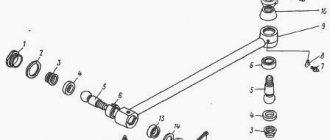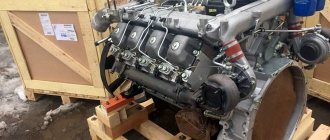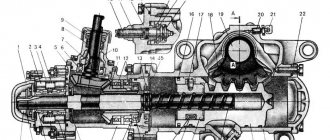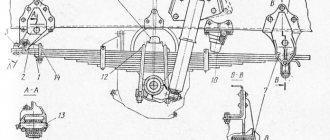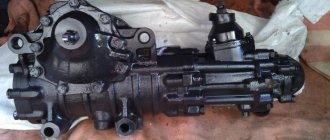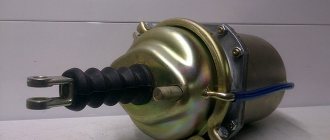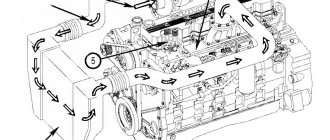Removing air from the power steering system on a KamAZ (correct “bleeding the steering”)
When filling the KamAZ power steering system with oil or after troubleshooting, it is necessary to remove air from it (“bleed” the steering).
To do this you need:
- Raise the front axle so that the wheels do not touch the ground. Using a jack, place trestles under the beam on both sides. But under no circumstances start pumping with the wheels standing on the ground. Or disconnect the longitudinal link from the steering bipod.
- Remove the pump reservoir filler cap.
- Remove the rubber cap from the steering gear bypass valve and place a transparent elastic hose on the spherical head of the valve, the open end of which is lowered into a glass container with a capacity of at least 0.5 liters. The vessel should be filled with oil to half its volume.
- Unscrew the steering gear bypass valve ½……3/4 turn.
- Turn the steering wheel LEFT until it stops.
- Pour oil into the pump reservoir until the level stops decreasing.
- Start the engine and, while operating at minimum crankshaft speed, add oil to the pump reservoir, not allowing the level to drop until air bubbles stop emitting from the hose placed on the bypass valve.
- Close the bypass valve.
- Turn the steering wheel to the RIGHT until it stops and back to the LEFT position. Keeping the steering wheel in the left position, unscrew the bypass valve ½……3/4 turn and again watch for the release of air bubbles. After the bubbles stop, close the bypass valve.
- Repeat the previous operation at least two times. As a result, clean (without air) oil should come out of the bypass valve. If the release of air bubbles continues, repeat the operation 1-2 more times, while monitoring the oil level in the pump reservoir, maintaining it between the marks on the level indicator.
- Stop the engine.
- Remove the hose from the spherical head of the bypass valve and place the protective cap on it. Check the oil level in the pump reservoir again and, if necessary, add oil. Install the pump reservoir filler cap. If you disconnected the longitudinal steering rod, install it in place.
The process of removing air from the system is complete.
Our advantages:
Professionalism:
Car repairs are carried out by highly qualified specialists with many years of experience in diagnosing and servicing Trucks and buses.
Speed:
Truck and bus repairs are carried out as quickly as possible; we have modern equipment and experienced personnel at our disposal.
Guarantees:
The guarantee applies to all types of work.
Steering
- with a hydraulic booster built into the steering mechanism, the working pair is a screw with a nut on circulating balls and a rack that engages with the toothed sector of the bipod shaft. The steering gear ratio varies from 18.2 in the middle position of the bipod to 21.5 in the extreme positions.
Steering mechanism
model C700VW.117.009 from RBL, installed on the left side member of the car frame. The cylindrical spur gearing of the piston and the bipod shaft has a high surface finish, so the wear of both gears is extremely small, which makes it possible to reduce maintenance of the steering mechanism to a minimum. The gearing of the bipod shaft in its middle position has no clearance.
The mechanism has a valve with a rotary spool, which consists of a rotary spool operating in a worm on a needle bearing with 6 metering grooves around the circumference and a worm head located in the steering gear housing, also equipped with 6 metering grooves. The worm and spool are drilled and pinned together with a torsion bar, which holds the metering valve in a neutral position, which corresponds to straight-line movement, until a counter force is applied to the steering wheel. If torque is transmitted from the steering wheel or steering wheels to the worm, the torsion bar is deformed and the rotary spool rotates relative to the worm head, thereby placing the metering valve in the operating position. The oil located at the metering valve enters through the now open metering grooves into one of the two cavities of the working cylinder and enhances the turning movement due to pressure on the piston surface.
The RBL mechanism is equipped with a hydraulic rotation limiter. This device prevents damage to the steering rods, since at the final position of the piston the adjusting screw rests against the limit valve, which allows oil to drain.
In this case, the hydraulic force is significantly reduced, and the steering wheel can be turned all the way only with additional effort.
Power steering pump
rudder model P1617 from RBL - bladed, with a capacity of at least 9.0 l / min at 600 min-1 and a pressure of 7000 kPa (70 kgf/cm2). The maximum pressure in the system is 17000 kPa (170 kgf/cm2). The pump drive is gear driven from the engine crankshaft.
The pump reservoir is equipped with a paper filter and an oil level indicator, mounted on the engine on an additional bracket. The paper filter must be changed every 100 thousand km.
The steering rods are tubular, with standardized ends. The threaded connection of one of the tips with the rod of the bipod allows you to adjust the length of the rod.
The steering wheel is located on the left. The drive from the steering wheel to the steering mechanism is carried out via a cardan shaft with a sliding spline connection and an angular transmission with bevel gears.
Power steering radiator
made of finned aluminum tube, located in front of the radiator of the engine cooling system.
Removing air from the hydraulic system
(pumping) is carried out with the longitudinal rod disconnected from the bipod.
To do this, turn the steering wheel to the right until the force begins to increase and return it to the left position again, repeat this cycle at least three times. Then add oil to the pump reservoir.
Oil level in the pump reservoir
Check the hydraulic booster with the engine running, with the front wheels of the car set straight.
The normal level should be between the marks on the tank body. Checking the oil level in the tank is done with a pointer mounted in the tank lid.
Bleeding and adjustment of PGU and GUR on KamAZ trucks
KamAZ PGU is a device designed to reduce the level of pressure exerted by the driver on the clutch pedal.
PGU - hydraulic power steering of a KamAZ pneumatic clutch type.
Design and principle of operation
The PGU device includes:
- spherical type nut;
- lock nut;
- a piston pusher that deactivates the clutch system;
- a cover that protects against damage;
- piston;
- complex type seal;
- bypass and inlet valve;
- cork;
- fuel fluid supply;
- system for compressing air flow.
The diagram also includes the following elements:
- spring mechanism;
- gearbox;
- diaphragm seats.
The operating principle of the PSU is as follows:
- The driver presses the clutch pedal.
- Under the pressure of the fuel fluid, the rod and piston part of the mechanism are activated.
- Movement occurs until the intake valve opens.
- The air flow moves in the direction of the pneumatic piston.
- The fork is retracted and the clutch system is disengaged.
Bleeding and adjustment
In order to adjust the CCGT, it is necessary:
- Adjust the pedal free play. Lower the pedal until the master cylinder starts to operate. After this, debugging is done using an eccentric finger. The gap between the piston part and the pusher should not exceed 1.2 cm. At the end of the procedure, you need to tighten the castle-type nut tightly.
- Adjust the clutch free play. Move the fork handle, remove the spring mechanism and perform debugging.
Procedure for pumping:
- Clean the rubber protective cap of the bypass valve.
- Place a rubber hose onto the valve.
- Place one end into a glass container with working fluid.
- Press the pedal jerkily 3 times, and the fourth time, while holding the pedal, loosen the bypass valve.
- As soon as the release of air bubbles from the liquid stops, you need to close the bypass valve and remove the hose.
Disassembly and repair
Repair of a CCGT unit involves its disassembly. To disassemble the mechanism with your own hands, you need to:
- Place the pneumatic power steering in a vice and clamp the rear housing.
- Unscrew the bolts and remove the air supply cover.
- Remove the amplifier valve from the front housing.
- Remove the spring and diaphragm.
- Pull out the thrust ring and piston part.
- Unscrew the mounting breather and remove the cover from the seal.
- Pull out the retaining ring.
- Remove the seats and washer.
- Remove the cuff.
- Installation and assembly of the KamAZ PGU is performed in the reverse order.
Possible malfunctions of the PSU:
- The drive is jammed. In this case, it is recommended to flush all hydraulic system elements and change the oil.
- The clutch is lagging. Use higher quality fuel fluid (for example, meeting Euro-5 standards). If this does not help, replace the piston seal.
- The clutch hisses and there is no boost. Inspect the intake valve and replace if necessary. It is also recommended to inspect the cuffs and the follower piston ring.
Signs of malfunctions in the power steering system
There are several signs that the power steering system is airy, in which case it is necessary to bleed it. Among them:
- the appearance of strong noise in the area where the power steering or its pump is installed;
- increased pressure on the steering wheel , difficulty turning it;
- leakage of working fluid from the power steering system.
In addition, there are several other signs that indicate the system is becoming airy - the appearance of foam on the surface of the working fluid in the expansion tank, spontaneous turns of the steering wheel to one side. If you encounter at least one of the described symptoms, it means you need to bleed your power steering.
Leveling up
There should be no air inside the working system. Removing it is called pumping. The general mechanization of power steering can be determined by the presence of the following systems:
- The power steering mechanism itself.
- To the right outgoing longitudinal thrust.
- Bipod.
- Oil radiator.
- High and low oil pressure pipelines.
- The pump adjacent to the expansion tank.
The main operating condition is the tightness of the system. If air appears, even a small air mass can get into almost any component, blocking its operation. Why is the seal broken? As a rule, air stagnation provokes a rupture of the oil pipeline, replacement of the pump, or any other repair that violates the tightness.
How to pump power steering
How to fill oil and bleed power steering
The procedure for replacing fluid and pumping power steering is carried out in strict accordance with the existing algorithm. Some automakers may add their own features to it. If you have a manual for your car, we recommend that you read the relevant section. In general terms, the steps must be performed in the following sequence:
- Raise the vehicle completely on a lift or with the front wheels off the ground.
- If necessary, drain the old fluid from the expansion tank. To do this, remove the return hose (going to the power steering system) from the expansion tank and put a plug on it so that liquid does not spill out of the hose. A hose leading to an empty bottle is connected to the released tap on the tank, where the old hydraulic fluid is supposed to be drained.
- It is most convenient to pump out the main volume of liquid with a syringe and pour it into a separate bottle. When there is very little liquid left, move on to the next point.
- Fill the expansion tank with working fluid to the top.
- Next, you should turn the steering wheel from side to side (from lock to lock) several times so that the old fluid remaining in the system flows out through the hose. Since the new fluid displaces the old, do not forget to monitor the oil level in the tank so that air does not get into the hose.
- If the fluid level drops, add it again.
- Start the engine for 2-3 seconds and turn it off. This is done so that the liquid begins to spread throughout the system.
How to bleed the power steering with your own hands: simple instructions
Hi all! The article was created specifically for owners of cars with power steering and those who plan to make a corresponding purchase in the future. We’ll talk to you about how to bleed the power steering, what is required for this and whether it is possible to do the work yourself.
Practice clearly shows that pumping is done in cases where the working fluid is being replaced, when signs of air congestion and malfunctions are detected. Typically, such a need arises as a result of breakdowns or after standard repair work affecting the power steering system. For example, bleeding is often carried out after replacing the rack.
If you do not expel the air that has entered the system, this will lead to a decrease in the efficiency of the hydraulic booster and provoke further malfunctions. In particular, you may encounter the fact that the pump will need to be replaced, and there will be no way to restore it.
Signs of trouble
On the Internet you can find many different videos and materials that discuss the issue of airing and problems in the power steering on cars of different types, classes and sizes.
Therefore, do not be surprised if you come across questions regarding power steering pumping:
- on KAMAZ;
- on Shakman;
- ZIL 130;
- on the Volga (GAZ 31105);
- in Scania;
- Toyota Corolla;
- Nissan Qashqai;
- Lada Priora;
- Renault Symbol;
- Ford Focus;
- Niva Chevrolet;
- Volkswagen Passat B3;
- Toyota Avensis;
- Skoda Octavia;
- Renault Logan, etc.
The automotive power steering system can become airy for reasons already stated, related to breakdowns, or structural interference in the power steering.
At the same time, every driver is recommended to be aware of the characteristic signs indicating the fact that the system is air-filled. It is when they appear that mandatory pumping is required.
There is nothing difficult in diagnosing and detecting the problem. Look for the appearance of one or several signs indicated in the list:
- there is a strong noise near the power steering itself;
- strong extraneous noise may come from the power steering pump;
- there is a clear increase in pressure on the steering wheel;
- the steering wheel becomes harder to turn during maneuvers;
- leakage of working fluid is observed from the system;
- foam appears on the surface in the expansion tank with hydraulic fluid;
- The steering wheel rotates spontaneously in different directions.
Even one of the signs indicates that the unit needs to be pumped. If there is air in the power steering system, you will already know the signs. All that remains is to deal with the issue of self-pumping.
We pump the power steering with our own hands
It is necessary to change the working fluid and pump the power steering system in strict accordance with the regulations and the established algorithm.
However, there are exceptions when automakers adjust the pumping process, trying to make it more convenient and simpler. With the instruction manual at hand, be sure to look at the correct section. There you will find everything you need related to the hydraulic booster installed specifically on your vehicle. Due to the introduction of some features of each car manufacturer and power steering systems, a universal pumping scheme cannot actually exist. There are several common points that are characteristic of all hydraulic boosters.
It is on them that I propose to place the main emphasis. This will give you the opportunity to understand what to do and what to build on when planning to bleed the power steering on your own car.
Initially, you will need appropriate conditions where you can lift the car completely or hang the front wheels. If necessary, the old fluid is drained from the expansion tank. To do this, remove the return hose from the tank and insert a plug into it. This will prevent hydraulic fluid from spilling out.
https://www.youtube.com/watch?v=Lx85ogkYF8c
Having released one of the taps on the tank, a hose connected to an empty plastic bottle is connected to it. It is there that the hydraulic mixture from the power steering system will subsequently be drained. This is the simplest and most common scheme.
To make it easier for you to pump out the bulk of the old fluid, you can use a syringe. As soon as a minimum volume of hydraulics remains in the reservoir, which can no longer be pumped out with this device, you can move on to the next stage. Namely, fill in new fluid to the upper mark on the expansion tank. After this, be sure to turn the front wheels in different directions and strictly until they stop. This will allow any remaining old fluid to drain out through the connected hose.
Please note that the new hydraulic oil will now displace the old one. Monitor the level carefully and try not to allow air to enter the system through the hose.
Further actions
We have already managed to cover about half the distance together. As you can see, nothing complicated yet. Everything can be done with your own hands, without having any special skills or deep knowledge.
Typical power steering malfunctions
Malfunctions in the operation of the hydraulic booster can be easily identified by characteristic signs. Among them:
- The steering wheel turns hard . Probable causes are failure of the power steering pump, use of unsuitable working fluid, sticking of the spool mechanism channels.
- , a high-frequency sound (similar to a whistle) is heard while driving The probable cause is a loose drive belt.
- The steering wheel turns jerkily . Probable causes of the malfunction are the working fluid not meeting the specifications declared by the manufacturer, a malfunction of the fluid distributing mechanism, or a pump malfunction.
- The presence of intense foaming in the expansion tank. Probable causes are mixing of different types of fluids, failure of the power steering pump.
- When the engine is running, the steering wheel spontaneously turns in any direction . The probable cause is malfunction of the spool mechanism, most often, clogging of its working channels, incorrect assembly (for example, after installing a repair kit).
Recommendations for operation and maintenance of power steering
In order for the power steering and its system to operate normally, as well as to extend their service life, you must adhere to several simple rules:
- use working fluids recommended by the automaker , and also replace them in a timely manner (most automakers recommend replacing power steering fluid every 60.120 thousand kilometers, or once every 2 years, it depends on the driving style and intensity of use of the car);
- carry out bleeding of the power steering system in strict accordance with the algorithm described above (or observing individual requirements, if any are set by the car manufacturer);
- monitor the condition of the steering rack boot , because if it is torn, dust and dirt will enter the system, which leads to the power steering pump exiting. A sign of a problem that has already occurred is the hum of the power steering, which is not eliminated even by replacing the fluid.
Cost of replacing fluid and pumping power steering
If you plan to carry out work on replacing the fluid and pumping the power steering yourself, then you will only need to buy oil in a volume of 1 to 3 liters (including flushing, while the volume of the power steering system of a passenger car is up to 1 liter). The price of the liquid depends on the brand and store. It is within $4.15 per liter. If you do not want or cannot carry out such work yourself, contact a service station for help. Approximate prices for January 2022 are:
- fluid replacement work - 1200 rubles;
- power steering pumping - 600 rubles.
Why might the power steering act up?
Bleeding the power steering system is necessary to remove air from the system when there is increased noise under the hood. You should pay attention to this feature: if the car hits an obstacle, then the wheels experience resistance, which tends to turn them around. The wheels close the drain line, and the working fluid moves into the cylinder. The piston enhances the action of the wheels working in reverse. In this case, the system prevents the wheels from turning. If the pump is turned off, the driver will feel the steering wheel become heavier, but the car can be driven even in this case.
The power steering system may show the following signs of malfunction: loud noise under the hood, increased pressure on the steering wheel, fluid leakage
. Increased noise may occur due to the presence of air in the system; the situation requires bleeding. It is necessary to bleed the power steering system when air gets into it during repairs or depressurization. This happens when the steering wheel jams (sharp turns, the pump makes noise when turning, the liquid is foamy). We suggest performing this operation yourself, let's think about how!
How to bleed the power steering on a KamAZ - The design and principle of operation of the hydraulic booster on a KamAZ
It’s hard to imagine how the truck would handle if it weren’t for the KamAZ power steering system. The operation of the parts and mechanisms of this device has become familiar to a heavy unit. The unit helps the user apply minimal force to turn the steering wheel. In addition, a number of complex functions are performed that affect the safety of the machine.
Each mechanism is subject to wear and tear, which will lead to loss of performance. Hydraulic power steering is no exception; the condition of the unit affects other components of the engine. That is why timely maintenance is important to maintain the performance of the amplifier.
The weak link in the steering is the hydraulics. The entry of air bubbles into the channels of the mechanism can stall the work and create an emergency situation. In order to respond to an emergency situation in a timely manner, an experienced user knows how to upgrade the power steering on a KamAZ and restore functionality.
Power steering system - device
After the steering wheel stops rotating, the spool stops. The drain line opens and the rotation of the wheels also stops. Thus, the main function of the hydraulic booster is to create comfortable driving conditions and increase safety, since the driver is able to drive even if the front tire breaks or the amplifier fails. In addition, power steering reduces the steering ratio, which accordingly allows for better maneuvering; it also reduces impacts on the steering wheel from the road and driver fatigue.
Purpose of the hydraulic power steering
The purpose of power steering is to reduce as much as possible the user's force applied to the steering wheel. In addition, the operation of KamAZ power steering affects stability when driving at low speeds. When moving quickly, in order to avoid an emergency, the amplifier creates additional resistance on the steering wheel. This stabilizes the ride along the road and keeps it on course.
The peculiarity of the power steering on the KamAZ-4310 and other models is that if the mechanism breaks down or fails, control of the vehicle is not lost, but remains in working order. The only drawback is that the user is forced to turn the steering wheel with greater force when turning the vehicle.
Question answer
Dear visitors to the LLC website, in this section you can get answers to your questions about the products supplied by our company.
The Minsk Automobile Plant enterprise is engaged in the production and production of heavy vehicles, trolleybuses and buses, as well as trailers. The Minsk Automobile Plant is well known both in the CIS and abroad.
Cummins supplies this engine without a pump and reservoir. Power steering pump 7685.955.138 manufactured by ZF Germany and tank C-123018 F. The RBL filter in the tank has the number PBR AC-3283.
On all cars 6522, 65221, 65222, 65224, 65225, 65226, in order to increase reliability, the bracket has been changed:
The specified tip, which was installed on the longitudinal rod, was canceled according to notice 6520.1187. Now the tip does not have a threaded part, but is crimped. To repair a longitudinal link, it is necessary to replace the link as it belongs to the vehicle. For example, cars 65115, 54115, 53215 require traction 53205-3414010, etc.
Externally, these thrusts are similar. They have the same tips 6520-3414059, however, on 5297 the rod itself without tips 5320-3414054 has a length of 1677 mm, and the rod without tips on 6520 has code 6520-3414053, and the length of which is 1636 mm. Everything else is identical. The rods are not interchangeable.
KAMAZ 4308 vehicles use different oil pumps depending on the engine. On the Brazilian one, a pump 3355528 is installed, on the Chinese one 3404A-001, the oil pump tank is the same C-123018 from RBL (Germany), the filter in the tank has the number PBR AC-3283.
According to notice 5320.11209, from August 15, 2005, the bipod rod 5320-3414010, included in the rod 5320-3414009, was replaced by the rod 53205-34140010. Spare parts are supplied with rod 53205-3414009 (see answer in question 6).
Bipods 53212 and 4310 are identical in design and mounting dimensions, but differ only in length. The distance along the axes of the holes is 4310...252 mm, 53212...262 mm. Bipod 4310 is used on cars with a front driven axle and power steering 4310, 53212 on cars with a non-driven front axle and power steering 4310. Bipod 43118 is externally similar to 4310 and 53212, but the distance between the axes of the holes for the bipod shaft and the bipod rod is 290 mm. Bipod 43118 is used on vehicles with power steering 715.101 (115-001).
Fuel, oils and special fluids for KAMAZ vehicles are specified in the operating manual.
Applicability of oils in the power steering system at low temperatures.
Oil grade “R” TU 38 1011282 (in power steering 4310-3400020).
The operating temperature should not be lower than - 25 0C.
"GIPOL-RS" produced by LLC "POLIEFIR" (Nizhny Novgorod)
Tests have been carried out at low temperatures. The test results are positive.
A decision was made to introduce TU 38 1011282 (in GUR 4310-3400020) instead of “R” brand oil.
SHELL-DONAX TA (Cars and buses with steering gears and “RBL”)
KamAZ power steering device
An amplifier is a set of parts and mechanisms combined into a closed system. The element bases are:
Directs streams of liquid (lubricant) into the nozzles, channels and cavities of the power steering.
- Volumetric hydraulic motor of reciprocating motion of a cylindrical shape.
The product converts the pressure generated by oil into the mechanical action of pistons and rods.
The working fluid, which is oil, is poured into the KamAZ power steering. The lubricant transmits force to the hydraulic cylinder from the pump. The material also prevents wear of surfaces, acting as a lubricant and sealant.
- Hydraulic power steering pump KamAZ-65115, etc.
The mechanism serves as a guarantor that maintains the level of constant pressure necessary for the normal functioning of the system. In addition, the pump constantly moves lubricant through the cavities and lines of the device.
Parts help connect and close parts, mechanisms, assemblies into one device.
The mechanism controls the operation of the system, analyzes and distributes efforts across work areas.
KamAZ power steering diagram:
Components
Like all mechanisms, power steering requires proper maintenance, timely diagnostics, and, if necessary, repairs and replacement of components. What are the components of the Kamaz hydraulic system?
- The electrical unit is the brains of any modern system. This component is part of the nodes of more modern models 5320, 6520; the basis of the system is the transmission of data by special sensors that characterize the operation of a highly loaded node.
- Hydraulic fluid flows through pipes and pipes, lubricating the mechanism. Without fluid, the operation of the unit is simply impossible, which is why its level always needs to be monitored. The liquid acts as a pressure transmitter for the hydraulic cylinder of the pump, is a lubricant for the elements of mechanisms, and helps to avoid unwanted friction.
- A hose system connects the pump, hydraulic cylinder, and filled tank, acting as communicating vessels. Thanks to the presence of lubricant, parts can work with the desired amplitude without friction.
- The required pressure is created inside the hydraulic cylinder thanks to the rod and piston.
- The distribution mechanism distributes power steering fluid throughout the entire unit, lubricating the cavities.
- The pump is an important part of the unit. It is he who pumps liquid inside the system. Pumps quite often fail, being a simple consumable.
The components of the hydraulic system are quite simple and few in number, so many drivers rebuild the hydraulic booster themselves. The first stage of maintenance is pumping.
Power steering pump
The pump is considered the main device of the amplifier, since it creates pressure for the KamAZ power steering, without which operation is not possible. The mechanism is mounted in the area of the power plant frame. The pump is powered by a motor and is driven by a gear transmission. The creation of lubricant pressure in the system occurs due to the blades with which the pump is equipped. The unit performs 2 cycles of fluid intake and release per revolution of the steering wheel. You can also read about the KAMAZ cab tilting (lifting) pump.
Operating principle of CCGT
Today, force converters of several types are built into vehicle transmissions, however, the operating principle of the KamAZ PGU is the same. Structurally, the mechanism is connected by two nodes placed in the frame:
- Tracking mechanism;
- A cylindrical chamber that performs functions using pneumatics.
The tracking device controls the PSU by monitoring the force with which the driver presses the foot clutch lever. When the pressure reaches the desired value, a portion of the air mass is supplied to the cylinder. The tracking device includes a membrane, which sometimes acts as a seal for the frame parts. The mechanism also includes a piston connected to the foot clutch lever via hydraulics. In addition, there are intake and exhaust valves, both of which are pneumatic and interact with the piston. Since both hydraulic and pneumatic elements are involved in the operation of the mechanism, both air and liquid are supplied to the CCGT unit.
Principle of operation
By turning the wheels of KamAZ-5410 and others, the rotor blades perform rotational movements and are adjacent to the stator. The parts that coincide with each other form passages into which lubricant is supplied and passes further due to the resulting pressure. The formed pressure pushes the liquid through the lower valve due to the fact that the oil, at the moment the passages of the distribution disk and the surface coincide, goes beyond the products.
Power steering pump KamAZ-65116, etc.:
The oil enters the rotor blades, having previously passed through the distribution disk. Due to the pressure, the blades adhere more strongly to the stator. The inlet and injection of liquid occurs simultaneously in two directions. An increase in rotor speed prevents the passage of lubricant through a calibrated hole from the area located behind the disk. The resulting pressure acts on the bypass valve, forcing it to open. As a result of valve activation, part of the working fluid passes through the manifold and again enters the suction surface.
Characteristics of power steering
First, let's look at the main characteristics of the power steering on a KAMAZ 6520 or any other model. Let's start with the purpose and device.
Purpose
The main purpose of the power steering system is to minimize the effort used to turn the steering wheel when steering, as well as performing many maneuvers when driving at low speeds. In addition, thanks to the power steering system, the impact on the steering wheel will be more noticeable if the car is moving at high speed. If the power steering fails for some reason, this will result in the driver having to exert significantly more effort to turn the steering wheel.
General diagram of the KAMAZ steering control operation
Device
Now let's briefly look at the power steering device.
This system consists of the following elements:
- Switchgear. This component is used to direct the flow of working fluids, in particular hydraulic oil, into the lines and cavities of the system.
- Hydraulic cylinder. This device performs the function of converting hydraulic pressure into mechanical work of pistons and rods.
- The working material in this case is hydraulic fluid. With its help, force is transferred from the pump to the hydraulic cylinder. In addition, thanks to the liquid, all rubbing components and components of the system are lubricated.
- KAMAZ power steering pump. Thanks to this device, the pressure required for normal operation is constantly maintained in the system. This element is also used to circulate the working fluid.
- Connecting elements or lines. They are used to bring together all the working components of the system.
- Control device or electronic unit. With its help, direction and adjustment of the operation of the amplifier are carried out.
Features of the pump
The pumping device is installed in the collapse of the BC. Domestic trucks use a gear top drive, but the device itself is of the blade type. In accordance with the technical documentation, this unit is characterized by double action, that is, with one turn of the steering wheel it carries out two cycles of suction and discharge.
Let's take a brief look at the operating principle. When the wheel turns, the rotor blades begin to rotate, which, in turn, are pressed against the stator device. Working fluid begins to flow into those blades that, when pressed, coincide with the holes on the body. Further, thanks to the same blades, the consumable material enters the narrower holes that exist between the stator and the rotor.
At the moment when the working surfaces can coincide with the holes on the distribution disk, the consumable material will come out beyond it. Next, the oil will pass through the lower valve; for this, high pressure is formed in the system.
The working fluid, leaving the cavity behind the distribution disk, will flow onto the rotor blades, as a result of which they will be pressed even more tightly against the stator plane. The process of pumping the substance, as well as its absorption, is carried out simultaneously in two places. As the number of revolutions of the rotor device increases, liquid from the surface behind the disk will not pass through the calibration hole. By creating pressure in the system, the bypass valve is opened, and part of the consumable material, through the manifold, is again supplied to the suction surface (the author of the video about replacing the hydraulic booster on a KAMAZ is Mathur Malay).
Important The best representatives of the LTZ tractor range
KamAZ power steering malfunctions
The advantage of the product is that KamAZ power steering malfunctions appear due to violations of operation and maintenance. Mechanism repair is a rare occurrence, but if breakdowns do occur, they occur at sub-zero temperatures.
Since the amplifier involves mechanics that interact between devices via hydraulics, faults are divided into:
- Mechanical type;
- Hydraulic type.
Replacing the KamAZ power steering oil seal:
Temperature changes negatively affect the hydraulics of the mechanism. Minus values make the working fluid thick, which increases the load on the oil seals and joint seals of the KamAZ-65222 vehicle, etc. The impact of increased pressure leads to oil leaks.
Violation of operating rules negatively affects the components and mechanisms of the amplifier. To extend the service life of the hydraulic booster, you need to take a competent approach to operation. So, leaving the car in the parking lot, the wheels of the vehicle are set to a level position. Otherwise, uneven load on the oil seal will lead to damage.
During the warm season, dirt and dust pose a danger. The penetration of abrasive particles into the mechanism of KamAZ-65117 and other models leads to increased friction and wear of the surfaces of parts. The impact entails depressurization of the system, wear of bushings, rods and other components.
Moisture seeps into the resulting gaps, causing rust on unprotected parts and causing increased wear. Operating the amplifier with similar problems leads to knocking in the steering rack, after which only replacing the KamAZ power steering will help. In order not to go to extremes, you need to tune the amplifier on time. The procedures performed are adjustment and pumping of the device.
Increase steering wheel power
Malfunctions of the power steering, which are manifested by an increase in force on the steering wheel, indicate a clogged system. In this case, you will need to check the filter element of the power steering reservoir. If it is noticeably clogged, the tank needs to be replaced.
Then flush the system by replacing the working fluid twice and then pumping the system. This operation should also be carried out when turbidity of the liquid is detected.
Pumping the KamAZ hydraulic booster
If the mechanism has been repaired or filled with fluid, the next mandatory action is to pump the KamAZ power steering. The procedure is performed to eliminate air bubbles trapped inside the amplifier. If the air is not eliminated, the useful effect of the hydraulic control will drop sharply.
Power steering diagram of a KamAZ car:
- Raise a car with a KamAZ-740 engine, or another model, so that the wheels of the car hang in the air. For this purpose, support the beams on supports.
Important. If at least one wheel is on the surface, the procedure for bleeding the hydraulic power steering is not carried out.
- Dismantle the filler plug of the expansion tank neck; Remove the rubber pad from the exhaust valve. Install the rubber tube in the vacant space, dip the free edge of the product into a container with lubricant in an amount of about 1/2 liter;
- Unscrew the transfer valve one-half turn;
- Turn the steering wheel all the way to the left, pour lubricant into the expansion tank;
- Start the power plant and let it idle. At this time, with the engine running, pour lubricant into the conservator reservoir, without allowing the level to drop. Make sure that no air bubbles come out of the valve tube - close the valve;
- Alternately turn the steering wheel to the right and left. Make sure that the steering wheel remains stationary, unscrew the bypass valve 1/2 turn. Check to see if any air bubbles come out. When air does not flow, tighten the valve;
- Repeat the procedure, bleeding the power steering in a similar way as many times as required. A sign of the end of the process is the release of clean liquid from the free end of the hose without air impurities. If bubbles continue to come out, regulation is continued until the bubbles disappear completely;
- Turn off the power plant, remove the pipe, install the cap, diagnose the level of working fluid in the expansion tank, and add oil.
Bleeding the power steering system - we do it ourselves
Pumping occurs as follows. Place the wheel in the middle (direction) position and turn on the motor for 15 seconds. Now turn the steering wheel a couple of times until it stops. Remove the protective cap and unscrew the valve. If the fluid level drops, add it again and start the engine. The fluid level should drop, but do not let it drop below about. The machine should run idle for a minute. We lower the car if it was in a suspended state and turn the steering wheel all the way for 2-3 seconds. We turn off the engine and wait for the foam to disappear, and then start the engine again and check the sound.
Bleeding can also be carried out with a special fitting. It is located on the power steering housing. We hang the front wheels, turn the steering wheel all the way with the engine off. Then we loosen the fitting a little, allowing the air to escape, and turn the wheel in the other direction. Liquid should appear from the fitting; when it comes out, you need to close the fitting and monitor the liquid level. Now lower the front wheels to their previous position, start the engine and turn the steering wheel from side to side. This exercise should be done until the bubbles of expelled air in the tank disappear.
If you find an error in the text, highlight it with the mouse and press Ctrl+Enter. Thank you.
Malfunctions of the power steering can lead to irreparable consequences, because driving a car, especially over long distances, is quite tiring, and the driver’s fatigue directly affects the increase in the likelihood of the car flying into a ditch or another accident.
Therefore, in order to alleviate the driver’s plight and reduce the likelihood of an accident, modern passenger cars are very often equipped with power steering. Initially, amplifiers were used only on trucks, but over time they also appeared on passenger cars.
The vehicle can be equipped with hydraulic, electro-hydraulic and electric power steering.
The most common are hydraulic boosters. Their design is not very complicated, but still, during the operation of the car, breakdowns of this steering unit may occur.
Malfunctions of the power steering can manifest themselves in the form of:
- Increased noise under the hood;
- Increased effort on the steering wheel;
- Leakage of working fluid.
